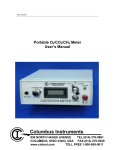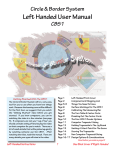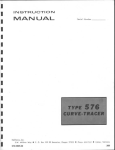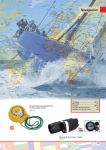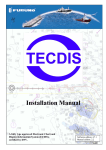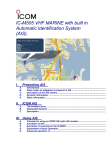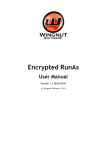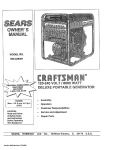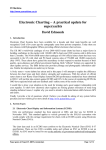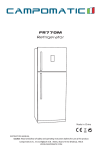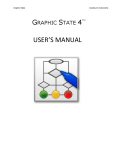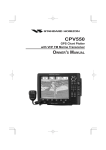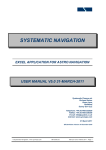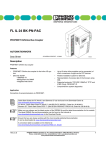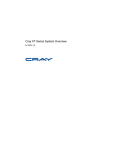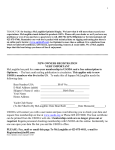Download JUL 2 4 2015 - United States Naval Academy
Transcript
DIVPRODEVINST 3530.2E JUL 2 4 2015 DIVISION OF PROFESSIONAL DEVELOPMENT INSTRUCTION 3530.2E Subj: SAIL TRAINING CRAFT NAVIGATION STANDARDS Ref: (a) Coastal and Offshore Personnel Qualification Standards (PQS) for Large Sail Training Craft (STC) Version 01-13 (b) Furuno NAVnet VX2 Marine Radar and Electronic Charting System (ECS) User Manual (c) Expedition Marine Navigation User Manual (VOST) (d) DIVPRODEVINST 3120.7, SOP for Large Sailing Training Craft Encl: (1) STC Navigation Report (2) Navy Sailing Chart Preparation Checklist (3) ECS Preparation Checklist Furuno/Expedition (4) ECS Display Requirements (for Jeppesen C-Map Digital Charts) (5) System settings for Expedition Software (VOST) (6) Navigation Brief Format 1. Purpose. To establish the navigation procedures and best practice for the United States Naval Academy (USNA) Sail Training Craft (STC) when operating both in the local OPAREA and when deployed offshore. 2. Cancellation. DIVPRODEVINST 3530.2D. 3. Background. The primary purpose of a STC is to enable safe and effective delivery of training for midshipmen in the subject of leadership, seamanship, and navigation when under sail. The responsibility for safety and delivery of training rests with those individuals embarked in each Craft that have completed the qualification process IAW reference (a). 4. Action a. Personnel charged with operating the STC underway shall review this instruction annually. b. All Skippers, Executive Officers, and Navigators are to become thoroughly familiar with the accuracy and use of all available methods for determining the current position and predicting future movement of the craft. DIVPRODEVINST 35 3 0. 2 E JUL ~ 4 ZUb c. The Director Naval Academy Sailing for reviewing this instruction annually. ~ A. G. G Distribution: (electronically) PRODEV DNAS Offshore Sail Training Squadron (OSTS) Varsity Offshore Sailing Team (VOST) Waterfront Readiness (WFR) SEANAV All students undertaking STC training 2 AS) is responsible DIVPRODEVINST 3530.2E JUL 2 4 2015 SAIL TRAINING CRAFT NAVIGATION STANDARDS 1. Background and Introduction. The safe navigation of a STC is a unique challenge, especially when operating under sail and in close quarters with other vessels. With the prevalence of Global Position Systems in the maritime environment and the accuracy of such systems, Electronic Navigation will serve as the primary navigational source underway. Handheld compass bearing positions with its inherent inaccuracy, will serve as a backup to GPS position keeping. A working knowledge of manual and chart navigation will be accomplished via exposure during training. The presence of an electronic chart system (ECS) can neither substitute for good judgment, sea sense, and taking all reasonable precautions to ensure the safety of the vessel and crew. An electronic chart system should be considered an aid to navigation, one of many the navigator might have at his or her disposal to help ensure a safe passage. While possessing revolutionary capabilities, it must be considered as a tool, not an infallible answer to all navigational problems. The rule for the use of electronic charts is the same as for all other aids to navigation: The prudent navigator will never rely completely on any single one. (The American Practical Navigator) The SOLAS (Safety of Life at Sea) Convention is published by the IMO (International Maritime Organization) at which the ISAF (International Sailing Federation) have Consultative Status. SOLAS Chapter V refers to the Safety of Navigation for all vessels at sea. While government vessels are not obliged to align with the convention the goal is to act in a manner consistent with, so far as reasonable and practicable. Within that chapter is the delegation of navigation to an electronic chart display and information system (ECDIS) system that precludes the carrying and navigation on paper charts. Since the STC craft lack the infrastructure to support such a system and instead employs an ECS, the system has to be used in conjunction with an appropriate portfolio of up-to date paper charts. 2. Navigation Team Organization Duties and Responsibilities. With respect to all aspects of navigation, the following duties and responsibilities exist as stated in reference (d) and are further amplified below: a. DNAS. Maintaining proficiency of basic maritime skills is critical to safe navigation. Additionally, a thorough understanding of the principles of operation , capabilities, and limitations of all installed equipment is essential knowledge. DNAS sponsored training programs and the qualification process of reference (a) must provide for accurate assessment and the necessary training to educate, qualify, evaluate , and periodically re-qualify assigned personnel. b. Skipper. The Skipper is ultimately responsible for the safety of the STC and all embarked personnel. He or she shall: (1) Ensure that safe seamanship and navigation is always the absol ute priority. 3 DIVPRODEVINST 3 530. 2 E JU L 2 4 201 5 (2) Review and approve/sign, all applicable paper charts. Charts should be prepared in accordance with enclosure (2). (3) Review and approve the Digital Voyage Plan in the ECS to include: Review and approval of the chart portfolio used on the ECS to ensure that all relevant vector and raster charts are included and that the most recent monthly update has been applied. Validation of the track, ensuring that all waypoints, and track legs/routes, precisely match those marked on the paper charts. (4) Ensure that all navigation equipment is properly configured in accordance with references (b) and (c) and enclosures (3), (4), and (5) (5) Ensure that the STC is operated in accordance with reference (d). (6) Take early and sufficient action to avoid collision and/or grounding. Ensure the Rules of the Road are followed at all times. (7) If unsure of the position of the craft, immediately slow or stop as appropriate given the situation. Establish a fix by GPS if possible, hand held GPS as backup, dead reckoning from last known position, or manual fix from handheld compass, and only recommence training once location of the craft is determined and assessed to be safe. c. Executive Officer (XO). The XO is collectively responsible for and will assist the Skipper as required with all tasks outlined above, additionally he or she is responsible for taking immediate action to avoid collision or grounding when the Skipper is off watch or otherwise unable to do so. d. Watch Team . When underway, it is essential that the entire watch team make a constant appraisal of the craft position, future movement, and safe speed. The installed ECS will provide the most accurate means to do so as long as it has been properly configured in accordance with enclosures ( 3) , ( 4) , ( 5) , and that accuracy checks are completed with Navigation reports. The Watch Captain is responsible for ensuring accuracy of navigation plotting and log keeping. If required, the Lookout or Sail Trimmer will act as a Bearing Taker using a handheld magnetic compass or sextant. e. Navigator. The Navigator and Assistant Navigator are responsible for all administrative navigation preparations prior to departure. The Navigator and Assistant Navigator are responsible for training the Nav Plotters in electronic and manual position fixing. (1) This includes preparing charts for Skipper's approval, ensuring all navigational resources are available onboard with a working knowledge of how they are utilized, configuration of th e navigation 4 DIVPRODEVINST 3530.2E .JUL ~J 4 ~'lll~J equipment onboard in accordance with enclosure (3) and review of weather forecast. (2) Underway they should give careful attention to the ship's course and speed and available depth of water when approaching land or shoals. (3) Personally supervise navigation of the ship, checking the electronic navigation with the plot on a corrected paper chart. (4) Stay aware of current and forecasted weather conditions. f. Plotter. The Plotter is a watch position assigned by the Watch Captain. This position may rotate during the watch, but care should be given about to not rotate the watch frequently when in restricted waters when it may prove hazardous to navigation. (1) Maintain situational awareness of the STC position, utilizing GPS, visual or radar. (2) Act as time keeper for the fix intervals. Check soundings as indicated by the fathometer with the charted depth after each fix. (3) Maintain the ship's navigation log with all applicable notations. (4) Proactively and loudly give the STC Navigation Report IAW enclosure (1). (5) Immediately notify the helm, Watch Captain CO, and/or XO when the determination is made that the STC is standing into danger. Ensure this report is acknowledged, and make course and speed recommendations to prevent the STC from entering dangerous waters. 3. Electronic Navigation. Shall be the primary method of navigation when underway and operating with electronic charts, all personnel shall reference the installed ECS for position keeping and supplement it with other sources as appropriate. An ECS must be considered as a single aid to navigation, and should be used with a corrected chart. 4. Position Log. A record of positions and soundings from all fix sources used shall be maintained as an official record of each fix taken. Position, course and speed, charted depth, fix type and fathometer soundings will be recorded at a minimum. The track option shall be enabled to record data via the Furuno system, the system recording limitations may require overwrite of some data. The Voyage Data Recorder of the ECS (where available) will also be enabled and may be used as an official record while racing (VOST only) . 5. Fix Interval. Fixes shall be entered in the log from the ECS and used to generate a STC navigation report, enclosure (1). Fixes should 5 DIVPRODEVINST 3530.2E JUL 2 4 20 15 not exceed 15 minutes while within 2NM of shoal water, NMT 30 minutes while between 2-10NM and NMT 60 minutes while 20NM or greater from shoal water. AREA DISTANCE FROM LAND / SHOAL WATER FIX INTERVAL Restricted Waters Less than 2 NM 3-15 Minutes or as conditions warrant* Piloting Waters Less than 2-10 NM 6- 15 Minutes or as conditions warrant* Coastal Waters Between 10-20 NM 15-30 Minutes or as cond i tions warrant* Open Ocean Greater Than 20 NM 30-60 Minutes *The Skipper/XO shal l determine or approve the f i x i nterval with respect to other actions on - deck, speed , distance to navigation hazards , and low visibility. 6. Paper Charts. Whi l e the ECS will be the primary navigation plot , manual plotting on paper charts shall be the secondary navigation plot. As a result, paper charts shall be prepared and maintained to be ready for their immediate use in the event of loss of the ECS. Additionally , even while maintaining ECS as the primary plot; manual paper plotting will increase situational awareness. While using paper charts , GPS shall still be used as the primary fix source in all waters. Visua l and/or radar fixes may be used at the discretion of the skipper. Fix i ntervals for paper plotting shall be in accordance with the table in paragraph 6. Skippers may adjust or relax the paper plotting requirement in restricted and piloting waters if the plotting activity is hindering situational awareness. 7. Navigation Instruction Exceptions a. OSTS and VOST Local area training/racing. During local area training/racing, navigation log keeping may be stood down once the craft has arrived in the pre-briefed training or racing area. b . VOST Racing. During VOST out of area, inshore racing competition, crews shall navigate to and from the pre-briefed startfinish lines of the race course. A digital log sha l l be maintained and electronic navigation sha l l be used while racing. c. An entry shall be made in the Deck Log when navigation is stood down and once again when resumed. 8. Procedures. The ECS will be used as the primary means of navigation, using all available resources listed below to ensure safe passage: 6 DIVPRODEVINST 35 3 0.2E JUL 2 4 201 5 a. Navigation Brief. Requirements prior to departing the Annapolis Operation Area. The geographical limits of the Annapolis OPAREA are defined as the Se vern River, seaward of Route 450 Bridge, north to the William P Lane Bridge and South to a line connecting Thomas Point Shoal Light and Bloody Pont Bar Light, or for VOST local racing only-North of a line connecting Green Can 83A and R84. ( 1) For squadron sail evolutions, (OSTS) an all-encompassing overall Transit Brief is an overview of the voyage to include weather, travel time and distance to be covered and all ensuing anticipated challenges to include every restricted water transit during the passage . This brief does not alleviate the need to do a truncated but still comprehensive crew Navigation Brief references enclosure (6) as well. The crew brief should cover specific restricted water transits that will be conducted within the following 12 hours. VOST shall prepare a likewise comprehensive Transit Brief to include crew, coaches, and sailing staff. (2) All local area training and any out of OPAREA restricted area transits will be discussed with a formal Navigation Brief pier side or underway within 12 hours of the transit. The Transit Brief will be the crew's opportunity to focus on transit data in detail for the specific area which is to be navigated. b. ECS Configuration. The ECS shall be properly configured prior to getting underway using the settings found in enclosures (3), (4), and (5). Failure to do so will jeopardize the craft, as safety critical issues may arise should the equipment not be properly configured. ECS will display the position, course, and speed from the selected GPS source at an update rate of approximately 1 Hz. c. ECS Accuracy. The accuracy of the electronic fix should be checked at available opportunities (each manual fix or on passing a conspicuous navigation aid) and by each available means including: through use of the fathometer, by radar, visually, by handheld magnetic compass or sextant. d. Resources. The following resources should be used for voyage planning prior to departure from USNA and for updates underway: (1) Tide and weather websites: (2) Publications. Eldridge tidal predictions, OPAREA appropriate Light Lists and Coast Pilots, or the full suite of Admiralty Digital Publications shall be carried aboard. 7 DIVPRODEVINST 3530.2E JUL 2 4 2015 (3) Paper Chart Folios. A master chart folio for the planned operating area with pre-planned tracks shall be prepared in advance. Any navigation track on paper should be supported by a series of verified waypoints entered into the ECS. A master database of approved digital navigation plans is retained by the VOST and OSTS Operations Officers. All charts, regardless of origin, must be correctly updated and prepared in accordance with enclosure (2). e. Hazard avoidance. The nearest danger to navigation (including nav aids and AIS contacts) is to be known by all watch standers on deck. The expected depth is to be reported by the Navigator to the Skipper/XO and other personnel in the Cockpit. Once the water is 18 feet or less, a constant watch is to be kept on the fathometer. The escape course and direction of safe water should also be known. f. Loss of ECS. In the event of a total loss of ECS, or when the Skipper wishes to demonstrate the use of paper charting to accomplish a specific training goal, the following procedures will be followed by the Navigator: (1) Slow or stop the Craft (as appropriate) and use all available means to fix position, including the use of the handheld GPS unit. (2) Simultaneously: Dead Reckon out from last known position based on ship's log while proceeding with a plot from a handheld GPS fix, radar or visual fix using the appropriate symbol and label it with a 4-digit time. Record the fix in the log and plot position on paper charts as needed (visual and radar fixes), ensuring that an appropriate fix interval is maintained. The fix interval is driven by distance from shoal water and the craft's speed. When operating within 1000 yards of danger, fix intervals should not exceed six minutes. (3) Immediately notify the Skipper and/or XO if unable to determine known position or plot a good fix. (4) Follow the six rules of dead reckoning (DR) after plotting a fix on the paper chart used for navigation. Always check the fix against the expected depth, taking into account tide fluctuation for the operating area. If not relying upon a GPS source for position, make an appropriate allowance for set and drift, calculate a future estimated position. Dead Reckoning (DR) must be maintained using the following six rules: (a) Plot a DR position at least every hour on the hour. (b) Plot a DR position at every course change. (c) Plot a DR position at every speed change (when under (d) Plot a DR position when obtaining a fix or running fix. power) . 8 DIVPRODEVINST 3530.2E JUL 2 4 2015 (e) Plot a DR position when obtaining a single Line of Position. (f) Plot and label with course, speed, and time a new course line from each fix or running fix as soon as it has been determined and plotted on the chart. This is accomplished whether the ship is on track or not. The DR plot should be for the next two fix intervals. 9. Vessel Characteristics. To ensure that safe seamanship and navigation is conducted near or in restricted waters, or under bridges and other elevated obstructions, it is critical that all embarked personnel know the vessel dimensions. 9 DIVPRODEVINST 3530.2E JUL 2 4 2015 Notes for Navigation Reports: 1. Relative bearing is the following: 270 would be port beam on current heading 2. .1 nm =200 yards 3. Reference nautical miles unless inside 200 yards. 4. Hazards: shoal water, unlit buoy, navaid, non-AIS traffic, AIS traffic, bridge, etc. SAIL TRAINING CRAFT NAVIGATION REPORT Last GPS fix verified good by fathometer expected depth lS feet. or Good I Poor Visual I Radar fix expected depth lS feet. nautical miles and Safe on this course for knots. minutes at current speed of or Recommend course change to heading degrees. range Closest hazard is - - - - relative bearing minutes at current speed. nautical miles or --Closet AIS contact is relative bearing range nautical miles. Closest Point of Approach (CPA) on --nautical miles. current course will be Next recommended course change lS ln minutes. Enclosure (1) 901. CHART PREPARATION CHECKLIST Ensure the chart is the latest edition and reference Notice to Mariners (NM) and Local Notice to Mariners (LNM) . For chart corrections refer to: http://ocsdata.ncd.noaa.gov/ntm/ and http://www.navcen.uscg.gov/?pageName=lnmMain. ----- Do not write on or mark over written information on (light characteristics, notes, etc.) while prepping each circling an aid to navigation with pen, leave a space in (or triangle) for text. Do not use red ink on the chart, show up under red light at night. --~- the chart chart. If the circle it will not Waypoints: Plot all in pencil on each chart using the waypoint list provided by the Operations Officer. Waypoints shall be a 1/8" solid round dot (no crosshairs), labeled with the four digit alpha numeric name of the waypoint (CN04) to coincide with the waypoint list. Create the track specified on the waypoint list with a pencil. ~--- ------ Shoal water (18 foot contour): Outline on the chart with a blue Sharpie Permanent Marker, Ultra Fine Point. Outline all shallow areas (18 feet or less) within the deeper water. Outline all fish traps and fish haven areas in 18 feet or less. Outline security areas (such as Cove Point LNG terminal). Corrections: Mark on the chart using the NTM and LNTM. Make ALL corrections to aids to navigation, and other corrections (shoal water, new obstructions, moved buoys, new fish trap areas, etc.) that occur in water 18 feet or deeper. Use Chart No. 1 as a reference to put new information on the chart, and the chart correction template to draw symbols. ----- Correction tree: create a tree with three columns on the middle left margin of the chart. The first column will be the NTM or LNTM number (designated by the week/year it was made, for example 42/11 is week 42 of 2011) . The second column is the date the correction was made by the chart preparer (1JUN12) and the third column is for the initials of the chart preparer (RM). If there are no corrections to be made, enter "00" in the NTM, the date and your initials as an indicator that the NTM was consulted. Use one line for each correction. Temporary corrections shall be made in black pencil, permanent corrections in black ink. ------ NTM 42/11 13/12 Date 1Jun12 1Jun12 Initials RM RM NTM 00 Date 1Jun12 Initials RM Chart sounding datum: Highlight in yellow fluorescent highlighter. ------ 1 Enclosure (2) DIVPRODEVINST 3530 .2 E JUL 2 4 201 5 Note if not in - -Geodetic Datum: Highlight in orange highlighter. WGS-84, and adjust chart plotter GPS on boat as needed. - -~_Magnetic ring of compass roses: Highlight all on the chart in yellow highlighter. Highlight variation if true only (offshore charts). - - - Unlit buoys: Identify all in water 18' or deeper by a 5/8" circle using a template; outline in black pen, and color with a green highlighter. Do not make "green" using a yellow and blue highlighter - it cannot be read under a red light at night. Bridges: For all bridges on track, highlight bridge controlling height, crossing point and center span location in yellow highlighter. --- Radar navigation aids: (navigation aids with a RACON and prominent points of land) Identify using a 5/8" triangle using a template; outline in black pen, and color with a blue highlighter. Radar nav aids will have a two or three figure identifier, with "R" as the first letter for Radar. RACON buoys will be labeled by their buoy number. Land or land based objects will use one or two letters following "R", i.e. "R P" for a pier or "R TP" for Turkey Point. --- Plot No less than, (NLT) and No more than, (NMT) lines from easily identifiable visual navigation markers. Plot as necessary to give a quick visual reference for heading to remain clear of shoal water areas when operating in coastal waters. These lines should be used as a reference in departure and terminal area charts. ---- Visual navigation aids: (lit and unlit buoys can be used in addition to land based visual aids such as lights on fixed structures, tanks, spires, and prominent points of land) Identify by using a 5/8" circle using a template; outline in black pen, and color with a yellow highlighter. Visual aids are used for shooting a line of position (LOP) and will have an identifier starting with "V" as the first letter. Buoys will be labeled by "V" and their buoy number, i.e. V 87 for buoy 87 on the Chesapeake Bay. Land based aids will use up to three letters or numbers following "V" i.e. V CD for Chapel Dome or V RT1 for Radio Tower 1. Ensure visual aids on overlapping charts have the same identifier for recording in the bearing log. Choose navigation aids that can be used in daylight and/or night, and that you can triangulat e for a fix . --- Fold and label the chart: With the chart face up fold right to left, bottom to top. Lay the chart down so that there is a single fold at the lower right hand corner. Label the cart in this corner. When the chart is placed in the navigation desk you should be able to see only a single edge and the label will be in the right hand corner. Label in legible 1" block letters on the bottom right had corner of the folded chart - the chart number and name. Immediately above the label, write the number of the connecting chart (from the c hart li s t provided by th e r e l e vant sailing program Operations --- 2 Enclosure (2) DIVPRODEVIN ST 3 530. 2 E JUL 2 4 2015 Officer); immediately below the label, write the c hart number of the following chart. The numbers of th e previous and following charts should be 1/3" l e tt e r. For example: Chart: 13 22 4 Chart: 13223 NARRAGANSET BAY INCLUDING NEWPORT HARBOR Chart: 13 2 18 Track: When approved by the Skipper, mark it with a black Sharpie, Ultra Fine Point. Each straight-line segment of the track will be labeled with the magnetic course (TRxxxM) and Speed of Advance in knots (SOA x .x). This marking will be placed along each segment at least once. --- - - -Approval: Each Skipper and XO is responsible for the final approval of their boat's charts. After review and making any necessary corrections, the Skipper will sign "Block # (year) Approved by: (Skipper and XO signatur e )" in the bottom left margin of the chart. 3 Enclosure (2) OIVPRODEVINST 3530.2E JUL 2 4 2015 ECS / CHART PLOTTER PREPARATION CHECKLIST FOR FURUNO Date: The Navigator shall review the following has been completed prior to getting underway and the XO or CO shall verify them . 1. Ensure Jeppesen C-Maps are current year May edition and that digital charts are loaded/ displayed with the latest available updates, check SD card for date prior to turning on Furuno. 2. Load the required voyage plans, ensuring that the tracks and waypoints are accurate. 3. Configure the Display Systems Settings and Vector Chart Features in accordance with enclosure (4). Refer to reference (b) 4. Verify the following safety cr i tical settings are correct: GPS SAT PAGE : Figure of merit VDOP<2 GPS Height: 003m AIS proximity a l arm : ON, 1nm GPS Setup: Geo - Dat um WGS-84 BG Depth Alarm : 12 Feet 5 . Ensure that Auto Chart Loading has been se l ected . 6 . Ch eck operation of radar . 7 . Set Own Ship I Track History to 8 hours. 8 . Set display range so nearest NAVAID is visible. 1 Enclosure (3 ) DIVPRODEVINST 3530.2E JUL 2 4 2015 ECS / CHART PLOTTER PREPARATION CHECKLIST FOR EXPEDITION Date: The Navigator shall review the following has been completed prior to getting underway and the XO or CO shall verify them. 1. Prior to turning on Furuno, check SD card for date. Ensure Jeppesen C-Maps are May edition for the current year and that digital charts are loaded/displayed with the latest available updates. 2. Load the required voyage plans, ensuring that the tracks and waypoints are accurate. 3. Configure the Display Systems Settings and Vector Chart Features in ac c ordance with enclosure (5/6). Refer to reference (c) 4. Verify the following safety critical settings are correct: SAFETY DEPTH: 18 feet. SAFETY HEIGHT: check STC owner's manual for each type of craft. SHALLOW CONTOUR: 18 feet. GPS SAT PAGE: Figure of merit VDOP<2 GPS Height: 003m AIS CPA/TCPA and proximity alarm: ON GPS Setup: Geo-Datum WGS-84 BG Depth Alarm: Draft +5 5. Ensure that Own Ship's Heading Vector is set to twice the fix interval (usually six minut e s). 6. Ensure that Auto Chart Loading selected. 7. Check all sensors that ar e enabled. 8. Set Own Ship I Track History to 8 hours. 9. Set display range so that nearest NAVAID is visible, reference safety status message. 2 Enclosure (3) DIVPRODEVINST 35 3 0. 2 E JUL 2 4 2015 ECS Display Requirements for Jeppesen C-Map Digital Charts (OSTS / VOST ) The default settings shall be enabled, reference (b), the following items shall be verified in settings, no other settings should be changed from the default settings: From: MENU/ System Configuration General Setup • Range Unit: nm , ft • Depth Unit: ft • Local time OFFSET: - 04:00 (NEXT PAGE) • LAT/LON: DO MM'SS.S • Mag Var: AUTO 11.2 W From: TRACKS & MARKS • AIS DISPLAY MODE: RANGE 20 nm • PROXIMITY ALARM: 00.2nm • CPA: 1 nm • TCPA: 1 min Interval/time: 10 sees CHART CONFIGURATION • Dec l utter: Off • Safety Status: On DEPTH CONFIG (Soft Key) • Depth Shading configuration: Manual • Depth Shading Display: Show from: 7ft to: 18ft AIS OPTION (So ft Key ) • MENU/ Chart Setup From : ALARM (Button under Trac kball ) • Audio Alarm set to ON* *After l e a v ing Sa nt ee Basin Nav Option/ GPS Sensor Settings (NEXT PAGE ) • Geodetic Datum: WGS - 84 • • • • Latitude: 38 58 57 N • Grounding Alarm: On 12 ft * Longitude: 076 2 8 43 w • Grounding Alarm Range : .25 nm Antenna Height: 003 M GPS Fix Mode: 20/30 B&G Fathometer Setup • MENU/SETUP/CALIBRATION/DEPTH DATUM : + 03.3 Ft • MENU/SETUP/ALARMS Depth (Lo) 12 feet ON *This enables a red triangle in front of the boat on the display. Once alarm triggered small red speaker icon appears on Furuno display go into the alarm status page to view what actually triggered the alarm. Enclosure (4) DIVPRODEVINST 3530.2E JUL 2 4 2015 Required System Settings for Expedition Software (VOST) The following items shall be enabled , reference (c), in Settings: System Settings • • • • Nautical miles Depth in feet Magnetic mode Local time Charts Common • • Lat/Long grid Rivers Tides • • Number Boxes (minimum required) • • • • • • • • • Depths • • • Depth (Yellow at top) SOG/COG (alternating) Boat speed Status Bar Marine All boxes except VAD bounds Chesapeake Rhode Island and MA • Scale Cursor position Magnetic variation Cursor range and bearing Cursor polar time Datum Depths Depth labels Soundings Navigation Aids • All boxes Underwater objects • All boxes Land • • • • • • Airports Bridge labels Height labels Natural features Landmarks Railways Enclosure (5) DIVPRODEVINST 3530.2E JUL 2 4 2015 NAVIGATION BRIEF FORMAT Track Overview , proximity of shoal water and other hazards to navigation, overview of total distance and safe haven rts. VOST review of NOR and Saili Instructions. What is the overall Speed, Time and Distance challenge in relation to estimated arrival time? Brief the weather forecast out to ETA + 12 hours for each of the course ( coastal , ocean). How will the predicted currents and tidal states impact the navigation plan and proposed dockage area transits and locations? and Portable SATCOM . plan, Ready for Sea Reports, outstanding maintenance items. First Aid, Fire, Flooding, Dismasting , Lightning Strike/Loss of Power, Loss of Steering , Abandon Ship , Procedures. put in place, personnel readiness. Brief lessons learned from previous cruises , and midshipmen lessons learned when licable. OTC brief squadron on specific instructions. Includes PAO briefing, in-port uniform requirements, housing arrangements , mandatory events, outreach obligations, liberty time, duty officer requirements , daily muster, watch standing, and departure preparations fuel, maintenance . Enclosure (6) DIVPRODEVINST 3530.2E JUL 2 4 2015 Notes for Navigation Reports: 1. Relative bearing is the following: 270 would be port beam on current heading 2. . 1 nm =200 yards 3. Reference nautical miles unless inside 200 yards. 4. Hazards: shoal water, unlit buoy, navaid, non-AIS traffic, AIS traffic, bridge, etc. SAIL TRAINING CRAFT NAVIGATION REPORT Last GPS fix verified good by fathometer expected depth lS feet. or Good I Poor Visual I Radar fix expected depth lS feet. Safe on this course for nautical miles and minutes at current speed of knots. or Recommend course change to heading degrees. Closest hazard is - - - - relative bearing range nautical miles or minutes at current speed. --Closet AIS contact is relative bearing range nautical miles. Closest Point of Approach (CPA) on --current course will be nautical miles. Next recommended course change lS ln minutes. Enclosure (1) DIVPRODEVINST 3530.2E JUL 2 4 2015 901. CHART PREPARATION CHECKLIST Ensure the chart is the latest edition and reference Notice to Mariners (NM) and Local Notice to Mariners (LNM) . For chart corrections refer to: http://ocsdata.ncd.noaa.gov/ntm/ and http://www.navcen.uscg.gov/?pageName=lnmMain. ---,-- - - - Do not write on or mark over written information on the chart (light characteristics, notes, etc.) while prepping each chart. If circling an aid to navigation with pen, leave a space in the circle (or triangle) for text. Do not use red ink on the chart, it will not show up under red light at night. Waypoints: Plot all in pencil on each chart using the waypoint list provided by the Operations Officer. Waypoints shall be a 1/8" solid round dot (no crosshairs), labeled with the four digit alpha numeric name of the waypoint (CN04) to coincide with the waypoint list. Create the track specified on the waypoint list with a pencil. --- Shoal water (18 foot contour): Outline on the chart with a blue Sharpie Permanent Marker, Ultra Fine Point. Outline all shallow areas (18 feet or less) within the deeper water. Outline all fish traps and fish haven areas in 18 feet or less. Outline security areas (such as Cove Point LNG terminal). --- - - -Corrections: Mark on the chart using the NTM and LNTM. Make ALL corrections to aids to navigation, and other corrections (shoal water, new obstructions, moved buoys, new fish trap areas, etc.) that occur in water 18 feet or deeper. Use Chart No. 1 as a reference to put new information on the chart, and the chart correction template to draw symbols. - - -Correction tree: create a tree with three columns on the middle left margin of the chart. The first column will be the NTM or LNTM number (designated by the week/year it was made, for example 42/11 is week 42 of 2011) . The second column is the date the correction was made by the chart preparer (1JUN12) and the third column is for the initials of the chart preparer (RM). If there are no corrections to be made, enter "00" in the NTM, the date and your initials as an indicator that the NTM was consulted. Use one line for each correction. Temporary corrections shall be made in black pencil, permanent corrections in black ink. NTM 42/11 13/12 Date 1Jun12 1Jun12 Initials RM RM NTM 00 Date 1Jun12 Initials RM Chart sounding datum: Highlight in yellow fluorescent highlighter. --,--- 1 Enclosure (2) Geodetic Datum: Highlight in orange highlighter. Note if not in WGS-84, and adjust chart plotter GPS on boat as needed. ---:- - - -Magnetic ring of compass roses: yellow highlighter. charts). Highlight all on the chart in Highlight variation if true only (offshore Unlit buoys: Identify all in water 18' or deeper by a 5/8" circle using a template; outline in black pen, and color with a green highlighter. Do not make "green" using a yellow and blue highlighter - it cannot be read under a red light at night. --- Bridges: For all bridges on track, highlight bridge controlling height, crossing point and center span location in yellow highlighter. --- Radar navigation aids: (navigation aids with a RACON and prominent points of land) Identify using a 5/8" triangle using a template; outline in black pen, and color with a blue highlighter. Radar nav aids will have a two or three figure identifier, with "R" as the first letter for Radar. RACON buoys will be labeled by their buoy number. Land or land based objects will use one or two letters following "R", i.e. "R P" for a pier or "R TP" for Turkey Point. ---,- Plot No less than, (NLT) and No more than, (NMT) lines from easily identifiable visual navigation markers. Plot as necessary to give a quick visual reference for heading to remain clear of shoal water areas when operating in coastal waters. These lines should be used as a reference in departure and terminal area charts. --,--- Visual navigation aids: (lit and unlit buoys can be used in addition to land based visual aids such as lights on fixed structures, tanks, spires, and prominent points of land) Identify by using a 5/8" circle using a template; outline in black pen, and color with a yellow highlighter. Visual aids are used for shooting a line of position (LOP) and will have an identifier starting with "V" as the first letter. Buoys will be labeled by "V" and their buoy number, i.e. V 87 for buoy 87 on the Chesapeake Bay. Land based aids will use up to three letters or numbers following "V" i.e. V CD for Chapel Dome or V RT1 for Radio Tower 1. Ensure visual aids on overlapping charts have the same identifier for recording in the bearing log. Choose navigation aids that can be used in daylight and/or night, and that you can triangulate for a fix. --- Fold and label the chart: With the chart face up fold right to left, bottom to top. Lay the chart down so that there is a single fold at the lower right hand corner. Label the cart in this corner. When the chart is placed in the navigation desk you should be able to see only a single edge and the label will be in the right hand corner. Label in legible 1" block letters on the bottom right had corner of the folded chart - the chart number and name. Immediately above the label, write the number of the connecting chart (from the chart list provided by the relevant sailing program Operations --- 2 Enclosure (2) DIVPRODEVINST 3530.2E JUL ~ 4 2015 Officer); immediately below the label, write the chart number of the following chart. The numbers of the previous and following charts should be 1/3" letter. For example: Chart: 13224 Chart: 13223 NARRAGANSET BAY INCLUDING NEWPORT HARBOR Chart: 13218 - - -Track: When approved by the Skipper, mark it with a black Sharpie, Ultra Fine Point. Each straight-line segment of the track will be labeled with the magnetic course (TRxxxM) and Speed of Advance in knots (SOA x.x). This marking will be placed along each segment at least once. Approval: Each Skipper and XO is responsible for the final approval of their boat's charts. After review and making any necessary corrections, the Skipper will sign "Block # (year) Approved by: (Skipper and XO signature)" in the bottom left margin of the chart. --- 3 Enclosure (2) DIVPRODEVINST 3530.2E JUL 2 4 2015 ECS / CHART PLOTTER PREPARATION CHECKLIST FOR FURUNO Date: The Navigator shall review the following has been completed prior to getting underway and the XO or CO shall verify them. 1. Ensure Jeppesen C-Maps are current year May edition and that digital charts are loaded/ displayed with the latest available updates, check SO card for date prior to turning on Furuno. 2. Load the required voyage plans, ensuring that the tracks and waypoints are accurate. 3. Configure the Display Systems Settings and Vector Chart Features in accordance with enclosure (4). Refer to reference (b) 4. Verify the following safety critical settings are correct: GPS SAT PAGE: Figure of merit VDOP<2 GPS Height: 003m AIS proximity alarm: ON, 1nm GPS Setup: Geo-Datum WGS-84 BG Depth Alarm : 12 Feet 5. Ensure that Auto Chart Loading has been selected. 6. Check operation of radar. 7. Set Own Ship I Track History to 8 hours. B. Set display range so nearest NAVAID is visible. 1 Enclosure (3) DIVPRODEVlNST 3530.2E JUt 2 4 ZOl:J ECS / CHART PLOTTER PREPARATION CHECKLIST FOR EXPEDITION Date: The Navigator shall review the following has been completed prior to getting underway and the XO or CO shall verify them . 1. Prior to turning on Furuno, check SD card for date. Ensure Jeppesen C-Maps are May edition for the current year and that digital charts are loaded/displayed with the l atest available updates. 2. Load the required voyage plans , ensuring that the tracks and waypoints are accurate. 3 . Configure the Display Systems Settings and Vector Chart Features in accordance with enclosure (5/6). Refer to reference (c) 4. Verify the following safety critical setti ng s are correct: SAFETY DEPTH: 18 feet. SAFETY HEIGHT: check STC owner ' s manual for each type of craft . SHALLOW CONTOUR: 18 feet. GPS SAT PAGE: Figure of merit VDOP<2 GPS Height: 003m AIS CPA/TCPA and proximity alarm : ON GPS Setup : Geo - Datum WGS-84 BG Depth Alarm : Draft +5 5. Ensure that Own Ship ' s Heading Vector is set to twice the fix interval (usually six minutes). 6 . Ensure t h at Auto Chart Loading selected . 7. Check all sensors that are enabled . 8 . Set Own Ship I Track History to 8 hours. 9. Set display range so that nearest NAVAID is visible, reference safety status message. 2 Enclosure (3) DIVPRODEVINST 3530.2E ~ 4 2015 JUL ECS Display Requirements for Jeppesen C-Map Digital Charts (OSTS/VOST) The default settings shall be enabled, reference (b), the following items shall be verified in settings, no other settings should be changed from the default settings: From: MENU/System Configuration General Setup • Range Unit: nm, ft • Depth Unit: ft • Local time OFFSET: -04:00 (NEXT PAGE) • LAT/LON: DD MM'SS.S • Mag Var: AUTO 11.2 W From: TRACKS & MARKS • AIS DISPLAY MODE: RANGE 20 nm • PROXIMITY ALARM: 00.2nm • CPA: 1 nm • TCPA: 1 min Interval/time: 10 sees CHART CONFIGURATION • Declutter: Off • Safety Status: On DEPTH CONFIG (Soft Key) • Depth Shading configuration: Manual • Depth Shading Display: Show from: 7ft to: 18ft AIS OPTION (Soft Key) • MENU/Chart Setup From: ALARM (Button under Trackball) • Audio Alarm set to ON* *After leaving Santee Basin Nav Option/GPS Sensor Settings (NEXT PAGE) • Geodetic Datum: WGS-84 • Latitude: 38 58 57 N • Grounding Alarm: On 12 ft * • Longitude: 076 28 43 W • Grounding Alarm Range: • Antenna Height: 003 M • GPS Fix Mode: 2D/3D .25 nm B&G Fathometer Setup • MENU/SETUP/CALIBRATION/DEPTH DATUM: + 03.3 Ft • MENU/SETUP/ALARMS Depth (Lo) 12 feet ON *This enables a red triangle in front of the boat on the display. Once alarm triggered small red speaker icon appears on Furuno display go into the alarm status page to view what actually triggered the alarm. Enclosure (4) DIVPRODEVINST 3530.2E JUL 2 4 201 5 Required System Settings for Expedition Software (VOST ) The following items shall be enab l ed, reference (c), in Settings: System Settings • • • • Nautical miles Depth in feet Magnetic mode Local time Charts Common • • Lat/Long grid Rivers Marine • Al l boxes except VAD bounds Depths • • • Tides • • Chesapeake Rhode Island and MA Number Boxes (minimum required) • • • Depth (Ye ll ow at top) SOG/COG (a l ternating) Boat speed Status Bar • • • • • • Scale Cursor posit i on Magnetic variation Cursor range and bearing Cursor polar time Datum Depths Depth labels Soundings Navigation Aids • All boxes Underwater objects • All boxes Land • • • • • • Airports Bridge . labels Height labels Natura l features Landmarks Railways Enclosure (5) DIVPRODEVINST 3530.2E JUL 2 4 2015 NAVIGATION BRIEF FORMAT Track Overview, proximity of shoal water and other hazards to navigation, overview of total distance and safe haven orts. VOST review of NOR and Saili Instructions. What is the overall Speed, Time and Distance challenge in relation to estimated arrival time? Brief the weather f cast out to ETA 12 hours for each le of the course ( , coastal, ocean How will the predicted currents and tidal states impact the navigation plan and proposed dockage area transits and locations? and Portable SATCOM. Fueling plan, Ready for Sea Reports, outstanding maintenance items. First Aid, Fire, Flooding, Dismasting, Lightning Strike/Loss of Power, Loss of Steering, Abandon Ship, Ma Procedures. put in place, personnel readiness. Brief lessons learned from previous cruises, and midshipmen lessons learned when a licable. OTC brief squadron on specific instructions. Includes PAO briefing, in-port uniform requirements, housing arrangements, mandatory events, outreach obligations, liberty time, duty officer requirements, daily muster, watch standing, and departure preparations fuel maintenance). Enclosure (6)




























